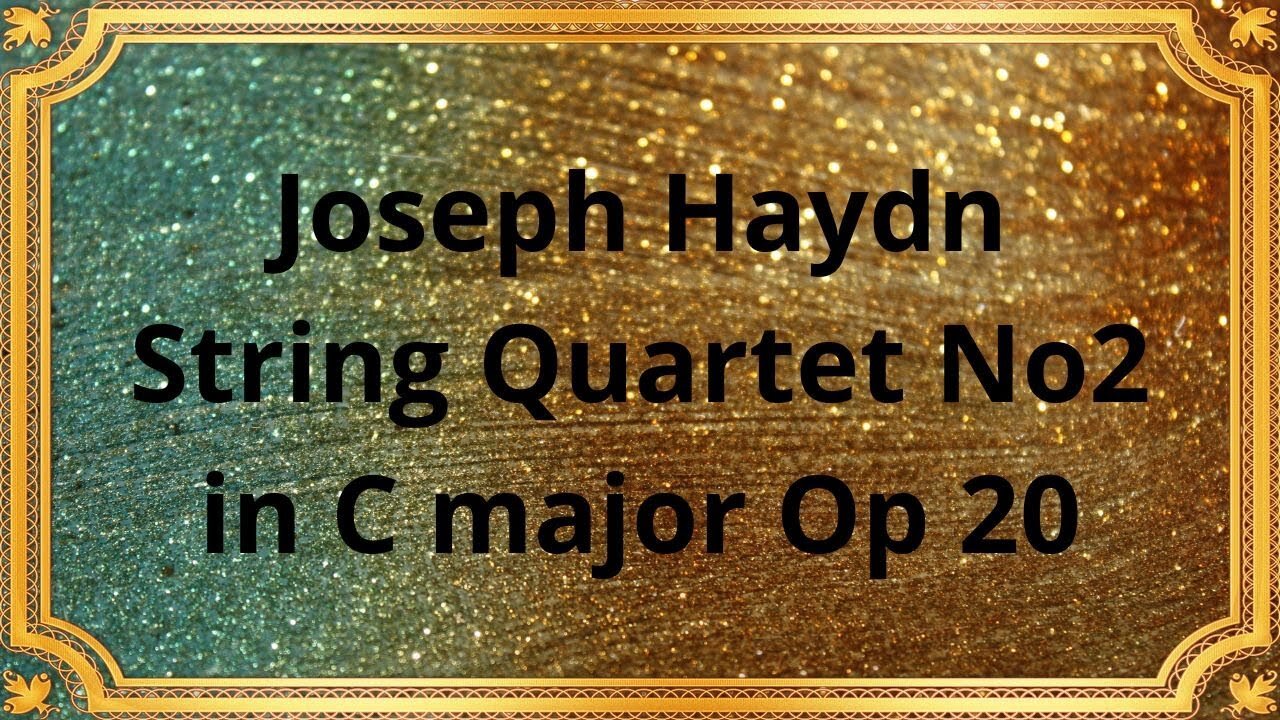Premium Only Content

Joseph Haydn String Quartet No2 in C major Op 20
#JosephHaydn #StringQuartet #Cmajor #Op20 #ClassicalMusic #MusicalComposition #ChamberMusic #ClassicalComposer #ClassicalEra
JOSEPH HAYDN COMPLETE STRING QUARTETS OF OP20
"The Sun Quartets"
Publication date 1952
SCHNEIDER QUARTET
Alexander Schneider, First Violin
Isidore Cohen, Second Violin
Karen Tuttle, viola
Madeline Foley, violoncello
Joseph Haydn, a pioneering figure in classical music, crafted an extensive repertoire that continues to captivate audiences today. Among his remarkable compositions, the String Quartet No. 2 in C major, Op. 20, holds a prominent place. In this essay, we will delve into the captivating world of this piece, exploring its historical significance, musical characteristics, and enduring impact on the world of classical music.
Composed in the 1770s, Haydn's Op. 20 quartets represented a significant milestone in the development of the string quartet genre. During this period, Haydn was in the service of Prince Nikolaus Esterházy, where he had the opportunity to experiment and push the boundaries of musical innovation. The Op. 20 quartets were the first of Haydn's works to be published as a set, solidifying his reputation as a leading composer of his time.
The String Quartet No. 2 in C major, Op. 20, showcases Haydn's remarkable musical craftsmanship. This quartet consists of four movements, each with its own distinct character. The opening movement, marked Allegro moderato, introduces a lively and joyful theme, reflecting the essence of the key of C major. The second movement, marked Capriccio, presents a playful and whimsical character, showcasing Haydn's wit and creativity. The third movement, marked Adagio, offers a serene and introspective experience, allowing the listener to immerse themselves in its expressive melodies. Finally, the quartet concludes with a spirited and energetic Finale, marked Allegro molto.
Haydn's Op. 20 quartet exhibits his mastery of form, harmony, and counterpoint. The interplay between the four string instruments creates a rich tapestry of sound, with each voice contributing to the overall texture and musical narrative. Haydn's meticulous attention to detail is evident in the seamless transitions between musical ideas, the use of dynamic contrasts, and the exploration of various tonal colors.
The String Quartet No. 2 in C major, Op. 20, played a significant role in shaping the future of the string quartet genre. Haydn's innovative approach to composition, including his use of thematic development, harmonic progression, and structural design, influenced generations of composers who followed. The Op. 20 quartets served as a source of inspiration for renowned composers such as Mozart and Beethoven, who went on to further expand and develop the genre.
Haydn's Op. 20 quartet continues to captivate audiences and remains an essential part of the classical music repertoire. Its enduring popularity can be attributed to the piece's timeless beauty, technical brilliance, and emotional depth. Performances of this quartet provide listeners with a glimpse into Haydn's creative genius, allowing them to appreciate his mastery of musical expression.
Conclusion:
Joseph Haydn's String Quartet No. 2 in C major, Op. 20, stands as a testament to the composer's musical brilliance and innovation. This quartet, with its distinctive musical characteristics, showcases Haydn's mastery of composition and his ability to create engaging and emotionally resonant music. The Op. 20 quartet holds historical significance as a milestone in the development of the string quartet genre and continues to inspire and captivate audiences with its timeless beauty. Haydn's enduring legacy lives on through this piece, which remains a cherished part of the classical music canon.
You have the opportunity to support the channel:
https://destream.net/live/RadSiarAl/donate
https://www.buymeacoffee.com/6355radsiaral
-
 34:26
34:26
Classical music_Music Inspiration
1 month agoAram Khachaturian Concerto for Violin and Orchestra
802 -
 9:54:54
9:54:54
Dr Disrespect
17 hours ago🔴LIVE - DR DISRESPECT - PUBG - 5 CHICKEN DINNERS CHALLENGE!
217K27 -
 1:58:28
1:58:28
Kim Iversen
10 hours agoSHOCKED! BETRAYED! RFK Jr. FLIPS on Measles Vaccine? | NATO Trap: Europe Could Drag The US to WW3
100K199 -
 18:37
18:37
Clownfish TV
8 hours agoThe Oscars Just EMBARASSED Disney and Emilia Pérez...
65.9K25 -
 56:28
56:28
Glenn Greenwald
10 hours agoDocumentary Exposing Repression in West Bank Wins at Oscars; Free Speech Lawyer Jenin Younes on Double Standards for Israel's Critics | SYSTEM UPDATE #416
111K84 -
 1:03:34
1:03:34
Donald Trump Jr.
12 hours agoZelensky Overplays His Hand, More Trump Wins, Plus Interview with Joe Bastardi | Triggered Ep.221
175K139 -
 1:13:16
1:13:16
We Like Shooting
21 hours ago $6.60 earnedDouble Tap 399 (Gun Podcast)
61.1K2 -
 1:00:20
1:00:20
The Tom Renz Show
1 day agoTrump Schools Zelensky, The Epstein Files FAIL, & What RFK Will Mean for Cancer
60.9K25 -
 42:47
42:47
Kimberly Guilfoyle
14 hours agoThe Trump effect: More Major Investment, Plus America First at Home & Abroad. Live w/Ned Ryun & Brett Tolman | Ep. 201
141K46 -
 1:29:23
1:29:23
Redacted News
12 hours agoWW3 ALERT! Europe pushes for war against Russia as Trump pushes peace and cutting off Zelensky
174K297